There are dozens of great dog harnesses available on the market, but an increasing number of dog owners are deciding to forego these commercial options and make their own DIY harness instead.
Care is certainly required when making a DIY harness, as they play an important role in your dog’s safety. But as long as you use suitable materials and think carefully about the type of harness you intend to make, custom-made harnesses can be great projects for DIY dog owners.
We’ll try to help you get started below, by discussing some of the reasons a DIY harness may be a good idea for you and explaining some of the most important things to consider when starting the project. We’ll even share 10 of the best DIY dog harness designs we could find!
Why Make Your Own Dog Harness?
There are a variety of reasons that owners may want to construct a homemade dog harness. Some of the most notable include the following.
- You want a harness in specific or unusual colors. Commercially made harnesses come in a variety of colors, but that doesn’t mean you’ll be able to find exactly the ones you want. But by making your own harness, you can pick whatever colors you like.
- You want to save a little money. In most cases, you can make a harness for less money than it’d cost you to buy one. You aren’t going to save a ton of money by doing so, but this can be a great way for budget-limited owners to save a few bucks.
- Your dog has an unusual build. Harnesses are typically designed to fit most dogs of a given size range, but you may have problems finding harnesses for dogs who are exceptionally thick, thinner than most, or have a barrel-chested build.
- Your dog has special needs. In some cases, you may need to construct a DIY dog harness that addresses any physical or mental challenges he experiences. For example, dogs with spine or hip problems may need a harness that features a handle, so that you can help him negotiate obstacles or get in and out of the car.
- You need a harness that works in a unique way. In some cases, you may need to build a DIY harness so that your dog can perform specialized tasks. For example, some dogs may need a harness that can be easily attached to a cart he is expected to pull, while others may need a harness that features LED lights, to provide additional nighttime safety.
- You simply enjoy making stuff. Many owners don’t need a special reason to make a DIY dog harness – they just enjoy these types of projects.
Important Things to Keep in Mind When Making a Dog Harness
As we mentioned before, it’s important to be careful when making a harness for your dog. If you take shortcuts or just slap something together, the harness could break and allow your pup to run free in a dangerous area. Consequently, you’ll want to keep the following things in mind when making a custom harness for your pup.
Use Suitably Strong Materials
It is always important to use materials that are strong enough to withstand your dog’s pulls and lunges.
There are no quick-and-easy guidelines to follow in this regard, but suffice to say, it is usually wise to select materials that are rated for at least three to four times your dog’s weight. In other words, if you have a 50-pound dog, you want to use webbing or rope that is rated for 150 to 200 pounds.
Keep Comfort in Mind
You don’t want your dog’s new harness to irritate or chafe his body, so try to use soft materials or padding in high-friction spots, like the chest, neck and armpit areas. A variety of materials work well for doing so, but fleece and faux fur are two of the best.
Measure Your Dog Carefully Before Starting
Many of the plans listed below provide guidelines for the harness dimensions, but you always want to measure your dog first to ensure the harness turns out to be the right size.
The circumference of your dog’s chest and neck are the two most important measurements, but you may also want to measure the distance between the front of his chest and his armpit region to ensure the length is correct too.
Pick a Design Befitting Your Skill Level
Picking a project that exceeds your skill level is a common mistake that you should try to avoid. Doing so will not only prove frustrating, it may even lead to mistakes that will compromise the security of the harness. So, if you are a beginning DIYer, be sure to pick one of the simpler designs listed below.
Always Test Harnesses in Enclosed Spaces
It is very important to verify that your dog’s new harness is secure before you start using it for daily walks. You don’t want the harness to break or it to slip off of your dog while you’re walking in an area with cars or other dangers.
You can test your harness at the dog park or a fenced backyard. If you don’t have access to either of these locations, just try it out in your living room.
10 Great DIY Dog Harnesses: Instructions & Plans
Now that you understand some of the reasons you may want to make your dog a custom harness and some of the important things to think about when carrying out the project, it’s time to pick a specific set of plans.
The following 10 are some of the best ones we could find, and you should be able to find a good one for your pet among those listed below.
1. DIY Dog Harness Made Out of Webbing
These DIY harness plans from Instructables show you how to make a harness that is very similar to the ones you’d buy on Amazon or at your local pet store. These instructions would be perfect for someone who wants to make a standard harness featuring custom colors.
This is also a great project for owners who want to save money, as you could probably construct this for less than the amount you’d spend on a similar, commercially produced model.
Difficulty: Moderate
Tools:
- Scissors
- Measuring tape
- Needle and thread or a sewing machine
- Cigarette lighter
Materials:
- Approximately 8 feet of webbing material (between ½ and 1 inch in width, depending on your dog’s size)
- 2 metal D rings
- 2 metal O rings
- 2 metal tri-glide sliders
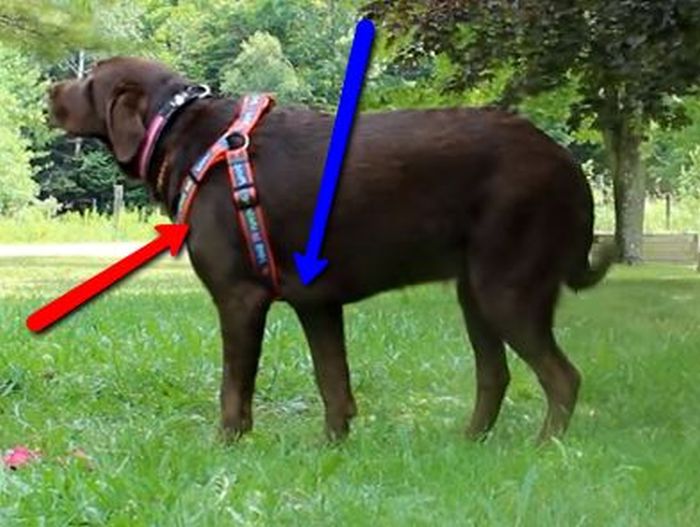
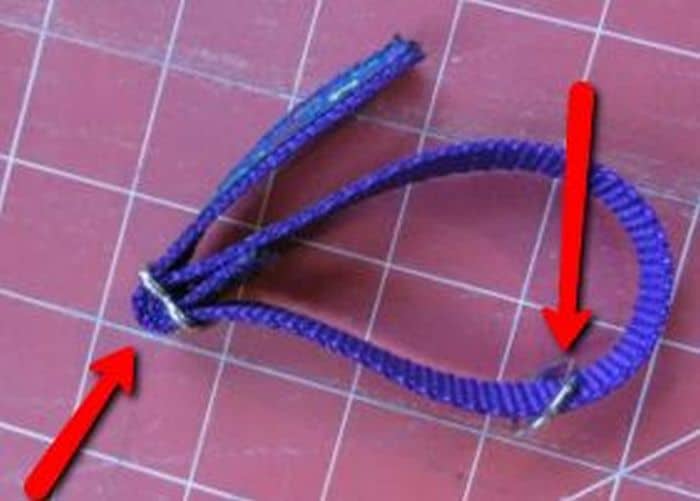
2. DIY Rope Dog Harness
These DIY rope harness plans from DoItYourself.com are great for owners who’d rather use rope than webbing to make their dog’s harness. Some dogs find rope harnesses more comfortable, and some owner simply prefer the way they look. But no matter why you want to build a rope harness, these plans should help you do so.
Difficulty: Easy
Tools:
- Scissors
- Measuring tape
- Needle and thread
Materials:
- Soft cotton rope
Unfortunately, there aren’t any photos included with these instructions. However, that shouldn’t be a problem for most owners – just follow the instructions carefully and you should be able to figure everything out.
3. DIY Dog Harness Made Out of Paracord
Paracord is a remarkably useful material that can be used to make everything from knife grips to beer koozies. You can also use paracord to make your own dog harness, as demonstrated by YouTuber ParacordingAround.
This doesn’t look like the easiest harness to build, and it will probably take you a bit of time to do so, but the final results look fantastic.
Difficulty: Moderate
Tools:
- Scissors
- 2 paracord fids
Materials:
- Paracord
- Plastic clip
- Metal D ring
4. DIY LED Dog Harness for Visibility
It is always important to ensure motorists can see your dog, and this is especially true for those of us who walk our dogs at night. These DIY Dog Harness plans from howchoo will help you do exactly that, as they rely on LEDs to help your dog standout like a lighthouse on a foggy night.
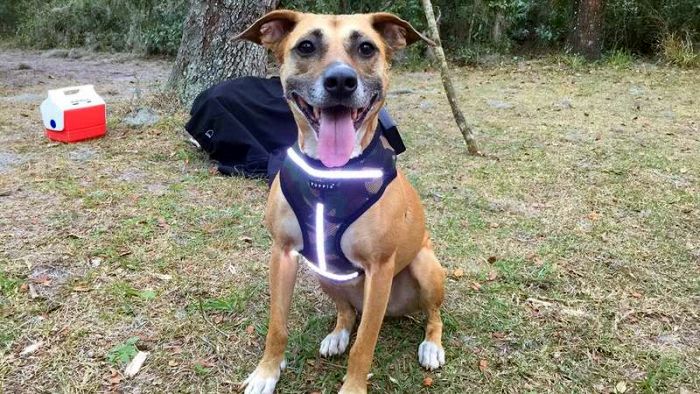
These plans demonstrate how to customize an existing harness rather than how to make one from scratch. It appears that you could use just about any harness to do so, so be sure to check out our review of the best dog harnesses on the market.
Difficulty: Difficult
Tools:
- Soldering iron
- Wire strippers
- Cigarette lighter
- Box cutter
- Multimeter
- Six alligator clips
Materials:
- Flux-cored solder
- Flux
- 3/16-inch heat-shrink tubing
- Eight AA batteries
- Waterproof LED strip light
- Two 6-volt AA battery holders
- Gorilla glue
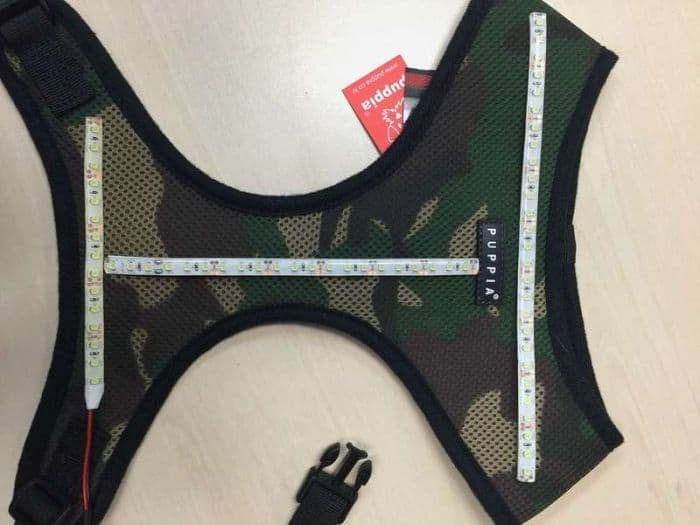
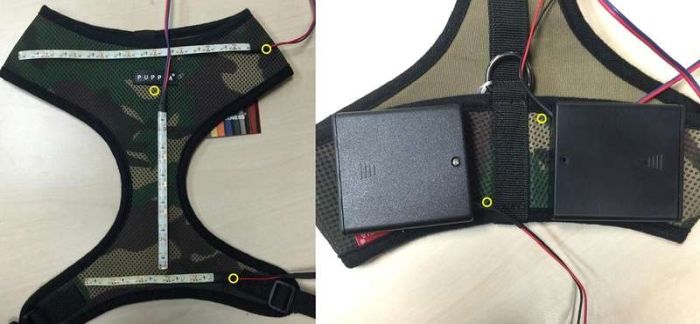
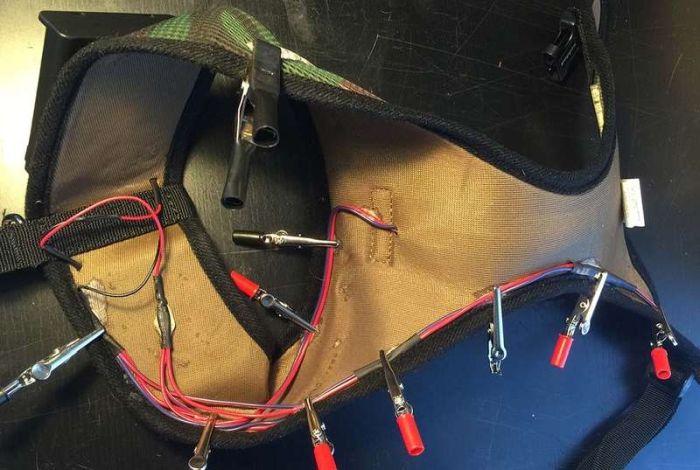
5. DIY Dog Cart Pulling Harness
These plans from Uberpest’s Journal demonstrate how to make a cart- or sled-pulling harness (the page actually includes several types of harnesses, but we’re focusing on the cart-pulling plans here).
These plans would not only be great for Iditarod hopefuls, but you could also use this kind of harness to let your dog pull a wheelbarrow or something similar.
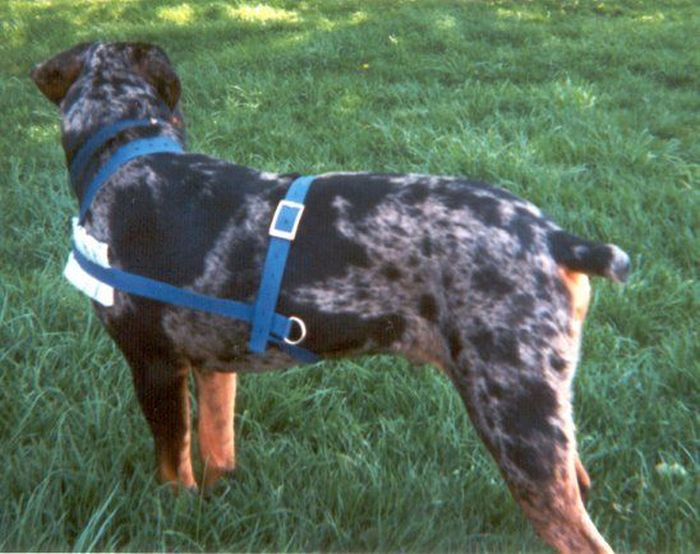
Difficulty: Moderate
Tools:
- Scissors
- Measuring tape
- Sewing needle
Materials:
- Two yards of 1″ nylon webbing
- Four feet of 1-1/2″ nylon webbing
- 1 yard of polyester fleece
- Polyester thread, dental floss or woven fishing line
- Two 1-1/2″ D-rings or two 1-1/2″ flat-eye snaps
- Two 1″ slide release buckles
- Two 1″ nylon or steel tri-glide sliders
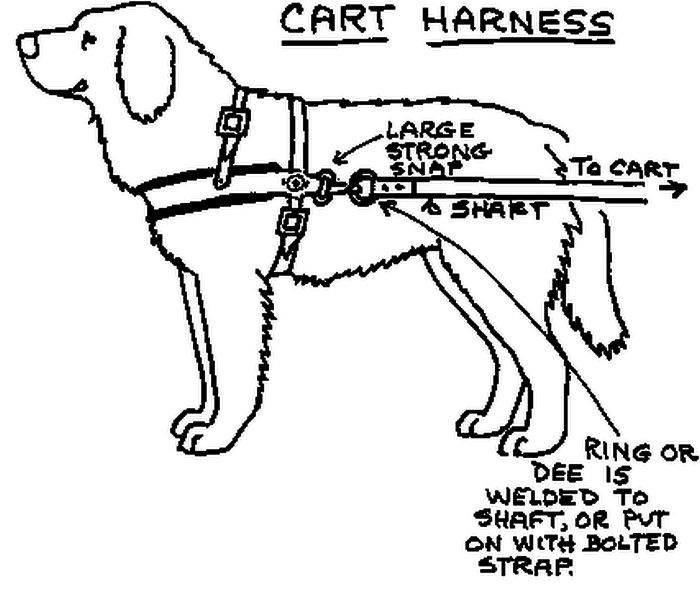
6. Homemade Adventure Go-Pro Dog Harness
There are two kinds of people in the world: Those who’ve already attached a Go-Pro camera to their dog’s harness to watch their dog’s unattended antics, and those who haven’t yet done so. I’m unfortunately a member of the latter group, so these harness plans from Instructables definitely caught my eye.
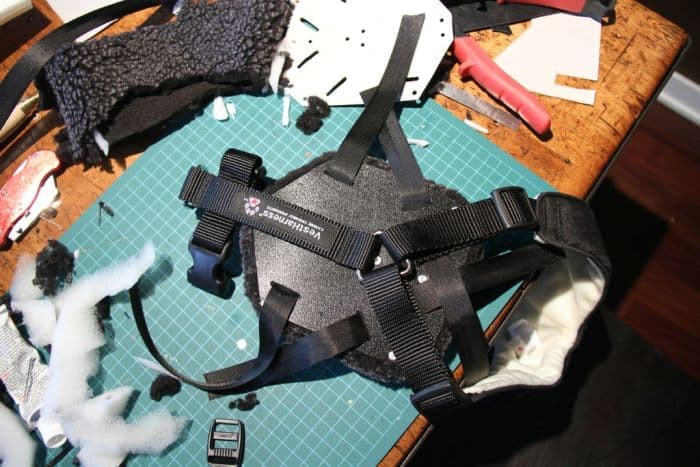
Like a few of the other plans we’ve listed here, these plans show you how to customize an existing harness, rather than to make a new one from scratch.
If you’d rather not bother with the crafting, you can purchase a Go-Pro compatible dog harness too!
Difficulty: Moderate
Tools:
- Tin snips
- Power drill
- Pop rivet gun
- Torch
- Box cutter/Exacto knife
- Ruler
- Pencil
Materials:
- Foam padding (firm and soft)
- Fabric for upholstering the pad
- Plastic sheeting
- Nylon webbing & buckles
- Rivets
- Contact cement
- Industrial strength Velcro
- Mounting piece for Go Pro camera (comes standard with your camera)
- Dog harness
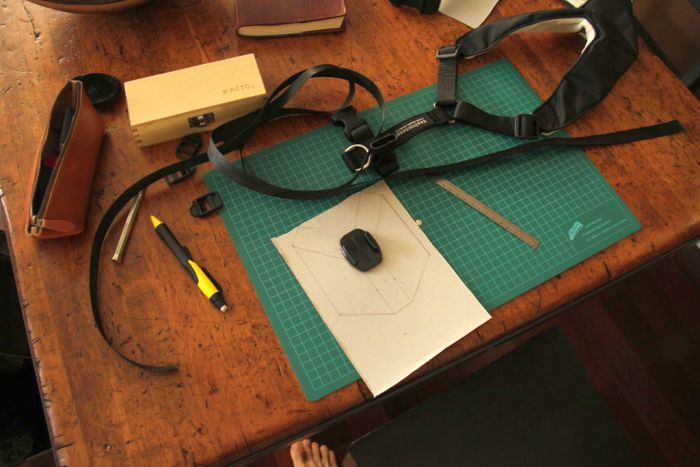
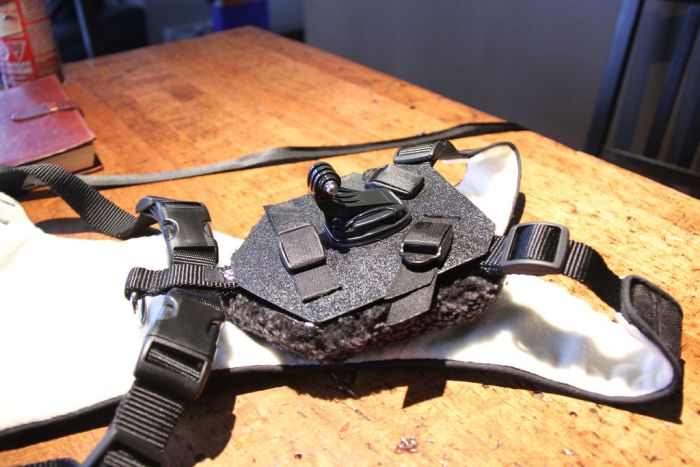
7. DIY Leather Dog Harness Template
Leather has been used to make garments and animal harnesses for thousands of years, and there’s a good reason why: It’s a fantastic material. Leather is durable, yet comfy; it’s a very handsome material; and you can use it in a variety of different ways.
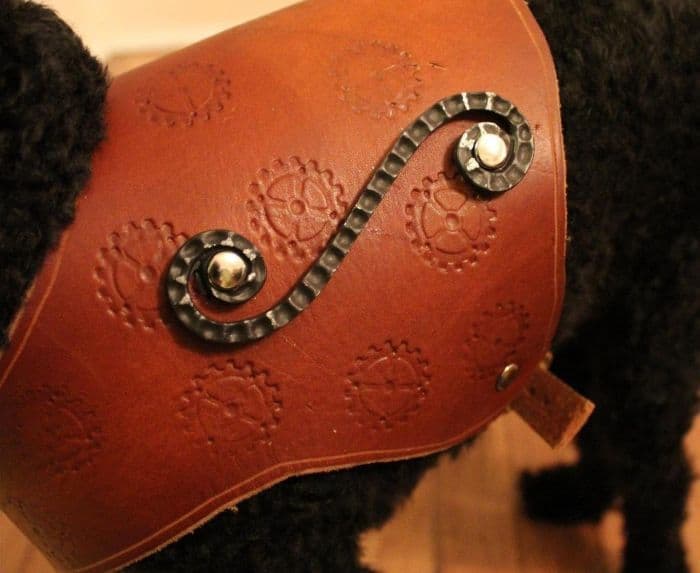
If you want to make a leather harness for your dog, check out these plans from Steampunk. These plans show you how to incorporate a number of cool design flourishes, but if (like me) you’re leather-crafting skills are at the novice level, you could surely simplify the plans.
Difficulty: Moderate
Tools:
Materials:
- Veg-tanned leather
- Leather screws or rivets
- Buckle
- Neatsfoot oil
- Metal gear
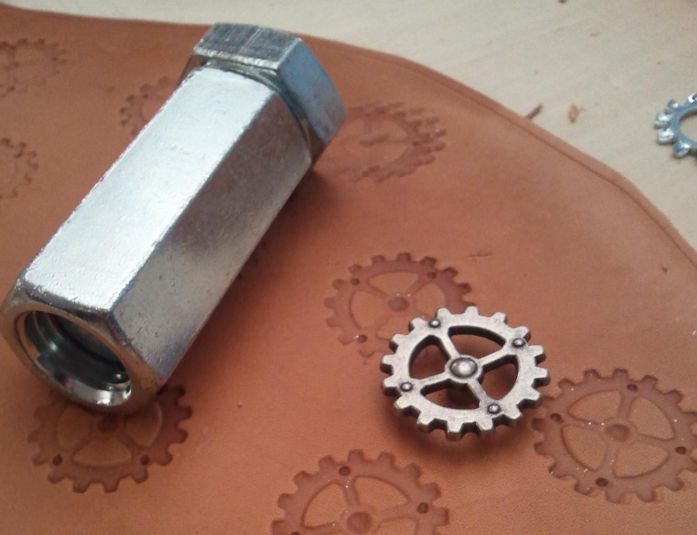
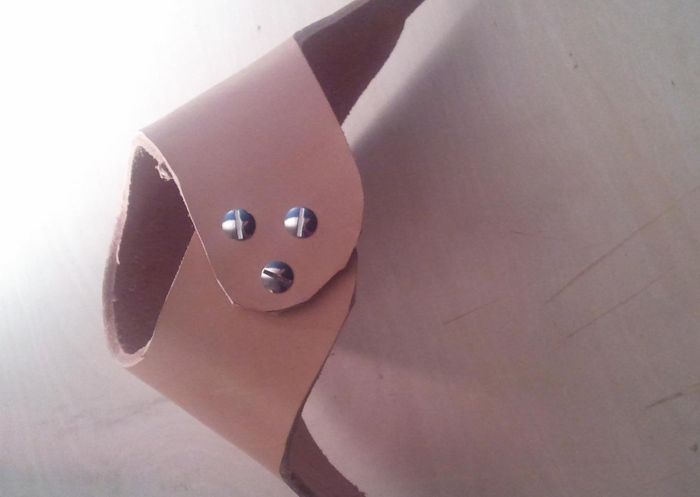
8. DIY Crochet Dog Harness
Crochet dog harnesses may not be ideal for outdoorsy pups or those who pull relentlessly on walks, but they’re perfect for well-behaved companion dogs. So, if you have a Chihuahua, Yorkie or some other adorable little toy breed, give these plans from Luvs-2-Knit a look.
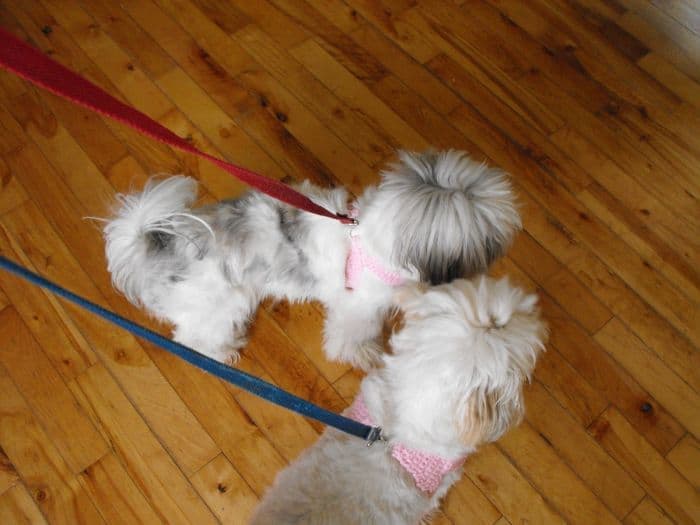
Difficulty: I’m calling this a “moderately difficult” project, but if you are already wise in the ways of crochet, it’ll probably be pretty easy to pull off.
Tools:
- Scissors
- Crochet hook
Materials:
- Yarn
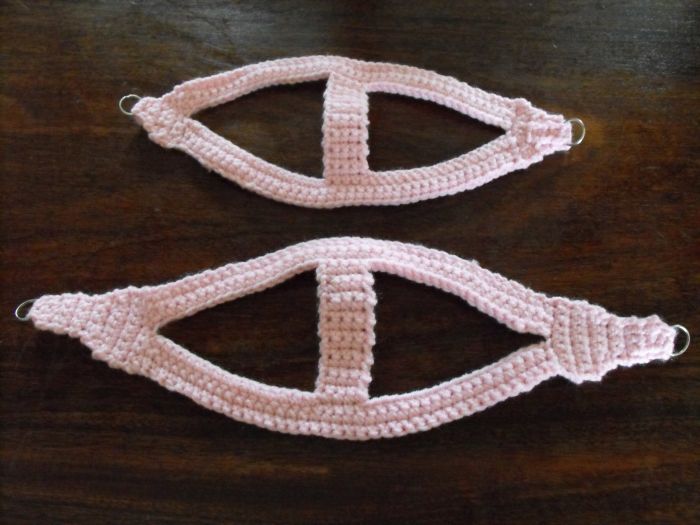
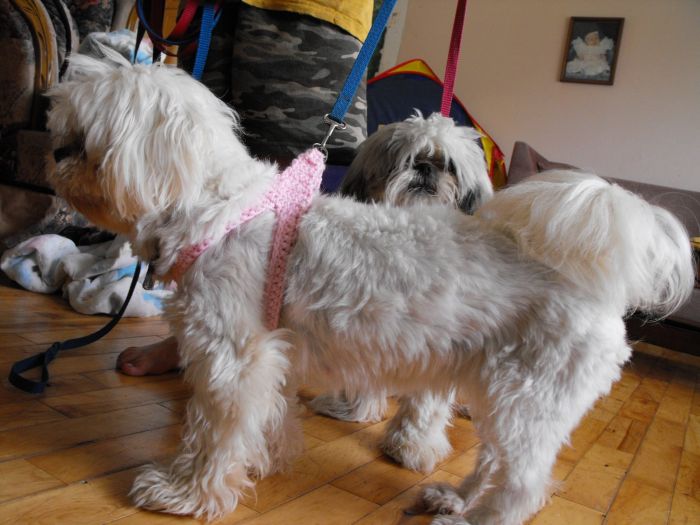
9. No-Pull Dog Harness Made Out of Leash
This DIY no-pull harness from Petful is a great option for owners of wannabe sled dogs who try to drag you around the neighborhood every time you leave the house.
These plans assume that you already have a collar and leash on-hand, and they show you how to rig them up in a way that’ll help discourage your dog from pulling.
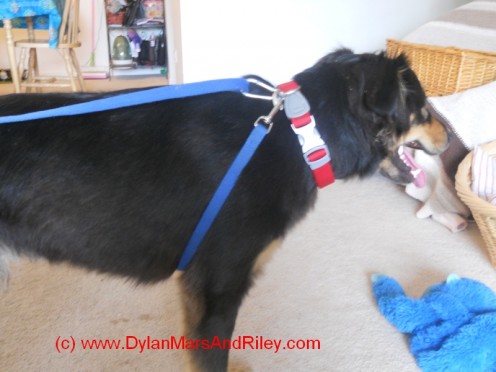
Difficulty: Easy
Tools:
- None
Materials:
- One leash
- One collar
- One heavy-duty carabiner
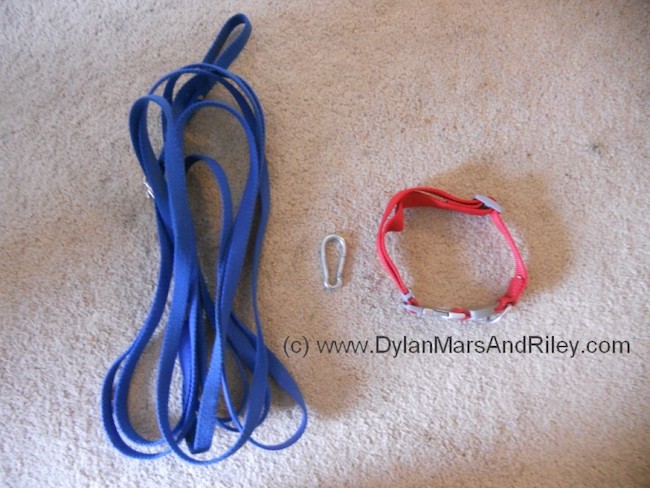
10. DIY Simple Sew Dog Harness (With Pattern)
If you know your way around a sewing machine, this DIY harness from SewMamaSew definitely deserves your consideration. This harness not only looks very functional, but it is also adorable too. So go ahead and download the pattern and get to work!
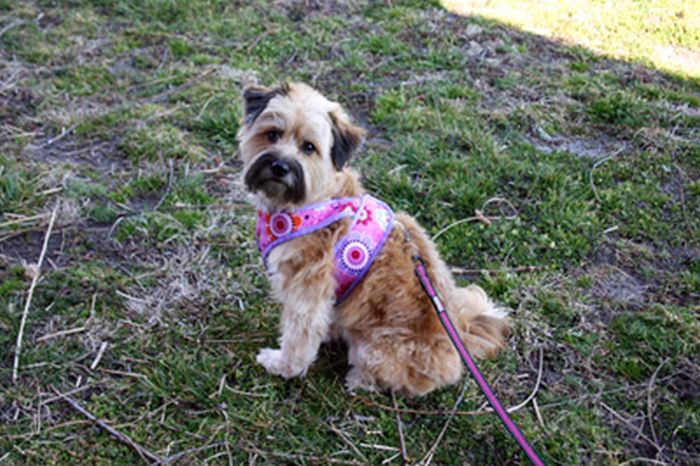
Difficulty: Moderate for non-sewers; easy for those who are handy with a needle and thread
Tools:
- Scissors
- Measuring tape
- Sewing machine
Materials:
- 1/3 – ½ yard cotton fabric
- 1/3 – ½ yard polar fleece
- One package of bias binding
- Two small D-rings
- Velcro
- 2 yards 5/8” grosgrain ribbon
- Thread
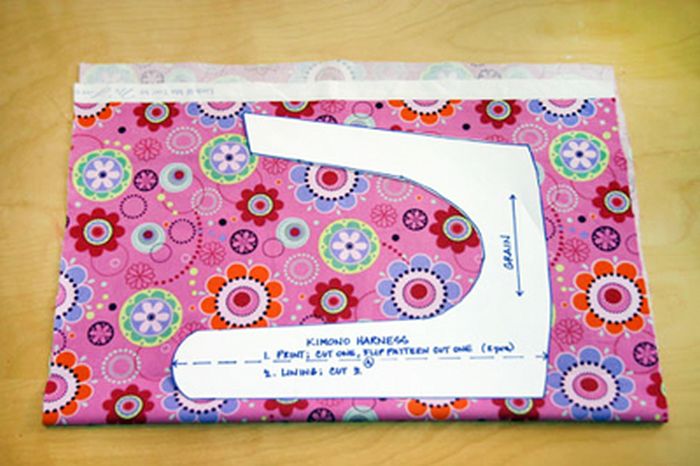
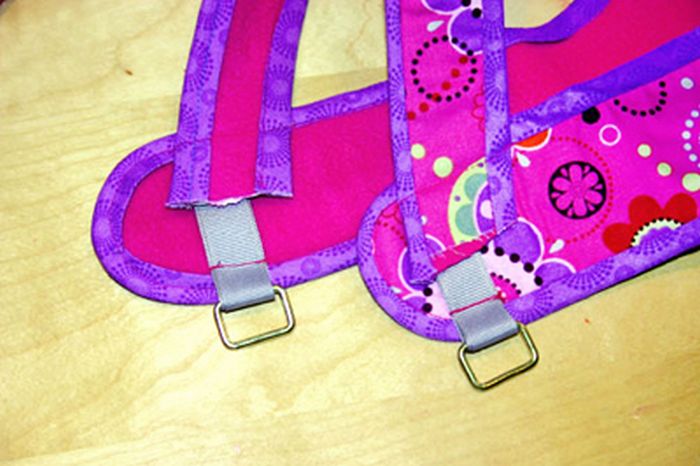
***
Have you ever tried to make any of these harnesses before? Have you found any great plans that we missed? Let us know all about your DIY harness-making experiences (as well as any tips you may have) in the comments below.
Want more fun DIY dog projects? See our guides on:
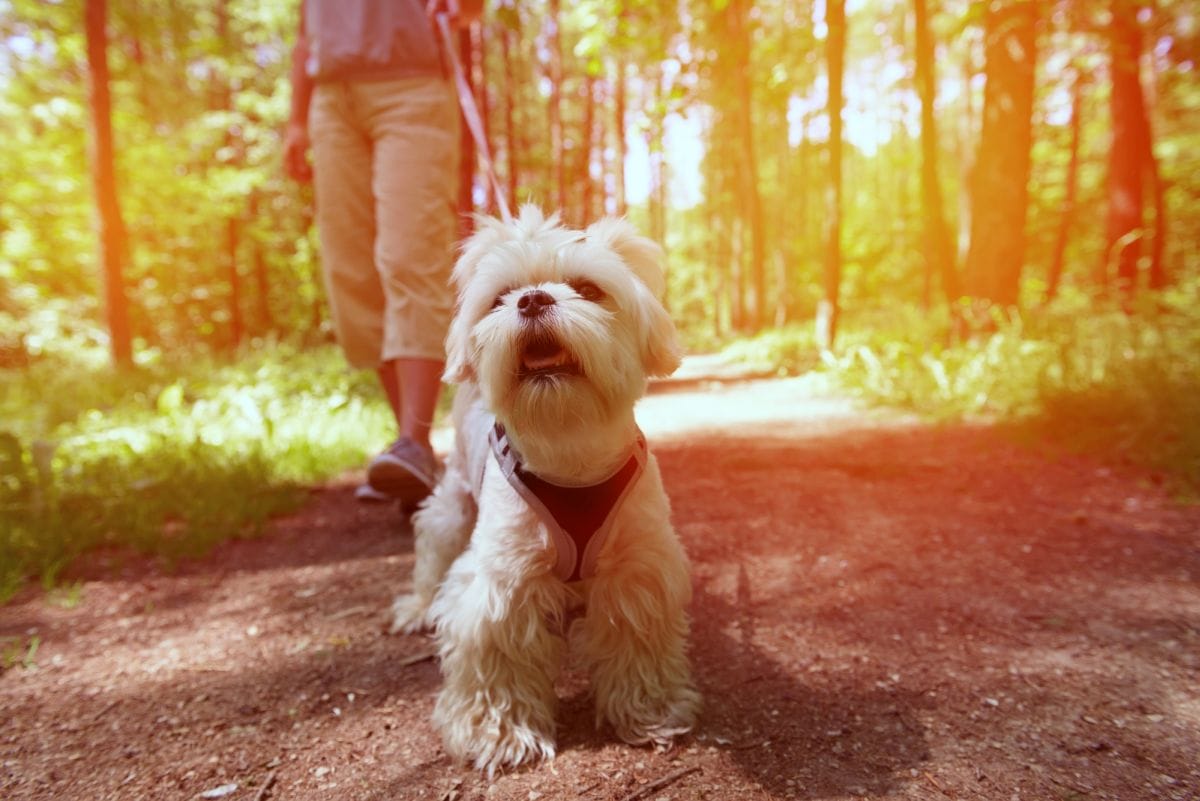

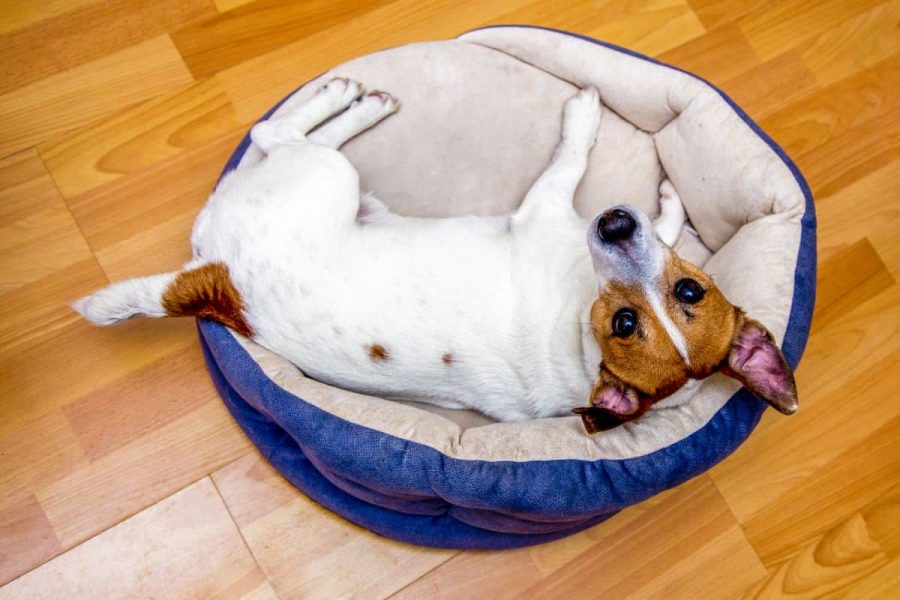








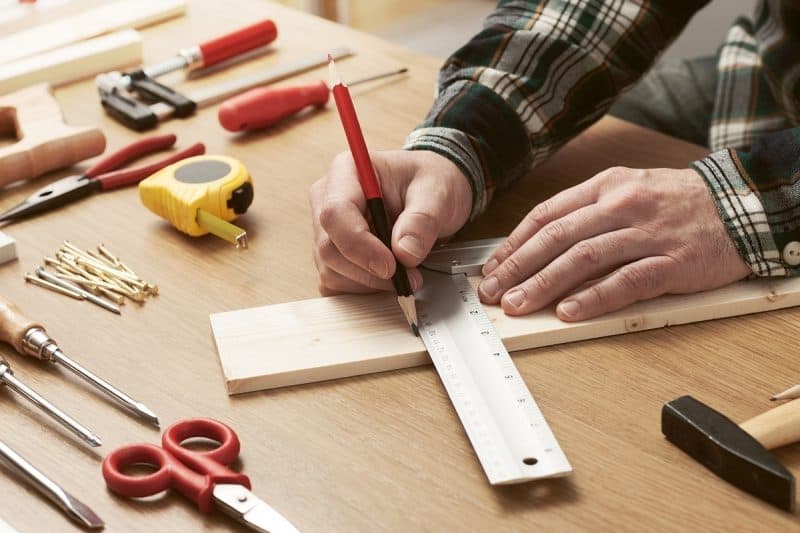

Leave a Comment